Analysis of Heat Generation on Unipolar Axial Eddy Current Brake Disc and Its Effect on Braking Performance
Abstract
1. Introduction
2. Materials and Methods
2.1. Basic Theory
2.2. Research Process
3. Results and Discussion
3.1. Heat Generation That Occurs in the ECB
3.2. ECB Heat Distribution Character
4. Conclusions
Author Contributions
Funding
Data Availability Statement
Conflicts of Interest
References
- Sawczuk, W.; Merkisz-Guranowska, A.; Ulbrich, D.; Kowalczyk, J.; Cañás, A.-M.R. Investigation and Modelling of the Weight Wear of Friction Pads of a Railway Disc Brake. Materials 2022, 15, 6312. [Google Scholar] [CrossRef] [PubMed]
- Zou, N.; Wang, Q.; Wang, W.; Zeng, X. Simulation Study of CVT Ratio Control for Engine Braking. In Proceedings of the 2009 International Conference on Measuring Technology and Mechatronics Automation, Zhangjiajie, China, 11–12 April 2009; pp. 367–370. [Google Scholar] [CrossRef]
- Putra, M.R.A.; Tjahjana, D.D.D.P. Fractures on braking component and relations to land-based transportation accident. Procedia Struct. Integr. 2020, 27, 147–154. [Google Scholar] [CrossRef]
- Pawar, N.M.; Khanuja, R.K.; Choudhary, P.; Velaga, N.R. Modelling braking behaviour and accident probability of drivers under increasing time pressure conditions. Accid. Anal. Prev. 2020, 136, 105401. [Google Scholar] [CrossRef] [PubMed]
- Popescu, F.D.; Radu, S.M.; Andraș, A.; Brînaș, I.; Budilică, D.I.; Popescu, V. Comparative Analysis of Mine Shaft Hoisting Systems’ Brake Temperature Using Finite Element Analysis (FEA). Materials 2022, 15, 3363. [Google Scholar] [CrossRef] [PubMed]
- Andras, A.; Brînaș, I.; Radu, S.M.; Popescu, F.D.; Popescu, V.; Budilică, D.I. Investigation of the Thermal Behaviour for the Disc-Pad Assembly of a Mine Hoist Brake Using COMSOL Multiphysics. Acta Tech. Napoc.-Ser. Appl. Math. Mech. Eng. 2021, 64, 227–234. [Google Scholar]
- Kamla, J.; Parry, T.; Dawson, A. Analysing truck harsh braking incidents to study roundabout accident risk. Accid. Anal. Prev. 2019, 122, 365–377. [Google Scholar] [CrossRef]
- Rainey, D.; Parenteau, M.A.; Kales, S.N. Sleep and Transportation Safety: Role of the Employer. Sleep Med. Clin. 2019, 14, 499–508. [Google Scholar] [CrossRef]
- Ghaleh, S.; Omidvari, M.; Nassiri, P.; Momeni, M.; Mohammadreza Miri Lavasani, S. Pattern of safety risk assessment in road fleet transportation of hazardous materials (oil materials). Saf. Sci. 2019, 116, 1–12. [Google Scholar] [CrossRef]
- Luo, N.; Jiang, J.; Yu, A. Research on the control strategy of the regenerative braking system. In Proceedings of the 2014 International Conference on Mechatronics and Control (ICMC), Jinzhou, China, 3–5 July 2014; pp. 2514–2517. [Google Scholar] [CrossRef]
- Kim, J.S.; Kim, S.M.; Jeong, J.H.; Jeong, S.C. Effect of regenerative braking energy on battery current balance in a parallel hybrid gasoline-electric vehicle under FTP-75 driving mode. Int. J. Automot. Technol. 2016, 17, 865–872. [Google Scholar] [CrossRef]
- Yazdanpanah, R.; Mirsalim, M. Hybrid Electromagnetic Brakes: Design and Performance Evaluation. IEEE Trans. Energy Convers. 2015, 30, 60–69. [Google Scholar] [CrossRef]
- Jee, I.H.; Nahm, S.Y.; Kang, S.J.; Ryu, K.-S. A Magnetic Brake for Small Wind Turbines. J. Magn. 2012, 17, 33–35. [Google Scholar] [CrossRef]
- Singh, A.K.; Ibraheem. Model Development of Eddy Current Brakes for Energy Absorbing System. In Proceedings of the 2015 International Conference on Recent Developments in Control, Automation and Power Engineering (RDCAPE), Noida, India, 12–13 March 2015. [Google Scholar]
- Luo, L.; Zhai, Q.; Li, W.; Qian, C.; Liu, H. Research on an integrated electromagnetic auxiliary disc brake device for motor vehicle. IEEJ Trans. Electr. Electron. Eng. 2017, 12, 434–439. [Google Scholar] [CrossRef]
- Anantha Krishna, G.L.; Sathish Kumar, K.M. Investigation on Eddy Current Braking Systems—A Review. Appl. Mech. Mater. 2014, 592, 1089–1093. [Google Scholar] [CrossRef]
- Singh, A.K.; Ibraheem; Sharma, A.K. Parameter identification of eddy current braking sytem for various applications. In Proceedings of the 2014 Innovative Applications of Computational Intelligence on Power, Energy and Controls with Their Impact on Humanity (CIPECH), Ghaziabad, India, 28–29 November 2014; pp. 191–195. [Google Scholar] [CrossRef]
- Thompson, M.T. Practical Issues in theUse of NdFeB Permanent Magnets in Maglev, Motors, Bearings, and Eddy Current Brakes. Proc. IEEE 2009, 97, 1758–1767. [Google Scholar] [CrossRef]
- Waloyo, H.; Ubaidillah, U.; Tjahjana, D.D.D.P.; Nizam, M.; Koga, T. Mini review on the design of axial type eddy current braking technology. Int. J. Power Electron. Drive Syst. 2019, 10, 2198. [Google Scholar] [CrossRef]
- Gulec, M.; Yolacan, E.; Aydin, M. Design, analysis and real time dynamic torque control of single-rotor–single-stator axial flux eddy current brake. IET Electr. Power Appl. 2016, 10, 869–876. [Google Scholar] [CrossRef]
- Garbiec, T.; Kowol, M.; Kołodziej, J. Design considerations of high-speed eddy-current brake. Arch. Electr. Eng. 2014, 63, 295–304. [Google Scholar] [CrossRef]
- Yazdanpanah, R.; Mirsalim, M. Analytical study of axial-flux hybrid excitation eddy current brakes. Int. J. Appl. Electromagn. Mech. 2015, 47, 885–896. [Google Scholar] [CrossRef]
- Sinmaz, A.; Gulbahce, M.O.; Kocabas, D.A. Design and finite element analysis of a radial-flux salient-pole eddy current brake. In Proceedings of the 2015 9th International Conference on Electrical and Electronics Engineering (ELECO), Bursa, Turkey, 26–28 November 2015; pp. 590–594. [Google Scholar] [CrossRef]
- Cho, S.; Liu, H.; Ahn, H.W.; Lee, J.; Lee, H.-W. Eddy Current Brake with a Two-Layer Structure: Calculation and Characterization of Braking Performance. IEEE Trans. Magn. 2017, 53, 5. [Google Scholar] [CrossRef]
- Jin, Y.; Kou, B.; Zhang, L.; Zhang, H.; Zhang, H. Magnetic and Thermal Analysis of a Halbach Permanent Magnet Eddy Current Brake. In Proceedings of the ICEMS 2016, 19th International Conference on Electrical Machines and Systems, Chiba, Japan, 13–16 November 2016. [Google Scholar]
- Park, M.-G.; Choi, J.-Y.; Shin, H.-J.; Jang, S.-M. Torque analysis and measurements of a permanent magnet type Eddy current brake with a Halbach magnet array based on analytical magnetic field calculations. J. Appl. Phys. 2014, 115, 17E707. [Google Scholar] [CrossRef]
- Jang, S.-M.; Lee, S.-H.; Jeong, S.-S. Characteristic analysis of eddy-current brake system using the linear Halbach array. IEEE Trans. Magn. 2002, 38, 2994–2996. [Google Scholar] [CrossRef]
- Jang, S.-M.; Jeong, S.-S.; Cha, S.-D. The application of linear Halbach array to eddy current rail brake system. IEEE Trans. Magn. 2001, 37, 2627–2629. [Google Scholar] [CrossRef]
- Ye, L.; Li, D.; Jiao, B. Three-dimensional electromagnetic analysis and design of permanent magnet retarder. Front. Mech. Eng. China 2010, 5, 438–441. [Google Scholar] [CrossRef]
- Smythe, W.R. On eddy currents in a rotating disk. Electr. Eng. 1942, 61, 681–684. [Google Scholar] [CrossRef]
- Sharif, S.; Sharif, K. Influence of Skin Effect on Torque of Cylindrical Eddy Current Brake. In Proceedings of the 2009 International Conference on Power Engineering, Energy and Electrical Drives, Lisbon, Portugal, 18–20 March 2009; pp. 535–539. [Google Scholar]
- Sharif, S.; Faiz, J.; Sharif, K. Performance analysis of a cylindrical eddy current brake. IET Electr. Power Appl. 2012, 6, 661. [Google Scholar] [CrossRef]
- Schieber, D. Unipolar induction braking of thin metal sheets. Proc. Inst. Electr. Eng. 1972, 119, 1499. [Google Scholar] [CrossRef]
- Singh, A. Theory of Eddy-Current Brakes With Thick Rotating Disc. Proc. Inst. Electr. Eng. 1977, 124, 373–376. [Google Scholar] [CrossRef]
- Karakoc, K.; Suleman, A.; Park, E.J. Analytical modeling of eddy current brakes with the application of time varying magnetic fields. Appl. Math. Model. 2016, 40, 1168–1179. [Google Scholar] [CrossRef]
- Gulbahce, M.O.; Nak, H.; Kocabas, D.A. Design of a mechanical load simulator having an excitation current controlled eddy current brake. In Proceedings of the 2013 3rd International Conference on Electric Power and Energy Conversion Systems, Istanbul, Turkey, 2–4 October 2013; pp. 1–5. [Google Scholar] [CrossRef]
- Karakoc, K.; Park, E.J.; Suleman, A. Improved braking torque generation capacity of an eddy current brake with time varying magnetic fields: A numerical study. Finite Elem. Anal. Des. 2012, 59, 66–75. [Google Scholar] [CrossRef]
- Cho, S.; Liu, H.C.; Lee, J.; Lee, C.M.; Go, S.C.; Ham, S.H.; Woo, J.H.; Lee, H.W. Design and Analysis of the Eddy Current Brake with the Winding Change. J. Magn. 2017, 22, 23–28. [Google Scholar] [CrossRef][Green Version]
- Cho, S.; Jeong, T.; Bae, J.; Yoo, C.; Lee, J. Analysis and Performance of the Self Excited Eddy Current Brake. J. Electr. Eng. Technol. 2017, 12, 459–465. [Google Scholar] [CrossRef][Green Version]
- Zhang, K.; Li, D.; Zheng, R.; Yin, W. Design and Performance of a Self-Excited and Liquid-Cooled Electromagnetic Retarder. IEEE Trans. Veh. Technol. 2015, 64, 13–20. [Google Scholar] [CrossRef]
- Bae, J.-N.; Kim, Y.-E.; Son, Y.-W.; Moon, H.-S.; Yoo, C.-H.; Lee, J. Self-Excited Induction Generator as an Auxiliary Brake for Heavy Vehicles and Its Analog Controller. IEEE Trans. Ind. Electron. 2015, 62, 3091–3100. [Google Scholar] [CrossRef]
- Zhang, K.; Li, D.; Du, X.; Zheng, R. Numerical Analysis and Experimentation of a Novel Self-Excited and Liquid-Cooled Eddy Current Retarder. IEEE Trans. Energy Convers. 2014, 29, 196–203. [Google Scholar] [CrossRef]
- Xiaojun, Y.; Ren, H.; Haijun, S. Calculation Method for Braking Torque of Self-excited Retarder. In Critical Issues in Transportation Systems Planning, Development, and Management; ASCE: Reston, VA, USA, 2009. [Google Scholar]
- Gulbahce, M.O.; Kocabas, D.A.; Habir, I. Finite elements analysis of a small power eddy current brake. In Proceedings of the 15th International Conference Mechatronika, Prague, Czech Republic, 5–7 December 2012. [Google Scholar]
- Rodrigues, O.; Taskar, O.; Sawardekar, S.; Clemente, H.; Dalvi, G. Design & Fabrication of Eddy Current Braking System. Int. Res. J. Eng. Technol. 2016, 3, 809–815. [Google Scholar]
- Gulec, M.; Aydin, M. Modelling and Analysis of a New Axial Flux Permanent Magnet Biased Eddy Current Brake. In Proceedings of the 22nd International Conference on Electrical Machines, ICEM 2016, Lausanne, Switzerland, 4–7 September 2016. [Google Scholar]
- Zagrodzki, P.; Truncone, S.A. Generation of hot spots in a wet multidisk clutch during short-term engagement. Wear 2003, 254, 474–491. [Google Scholar] [CrossRef]
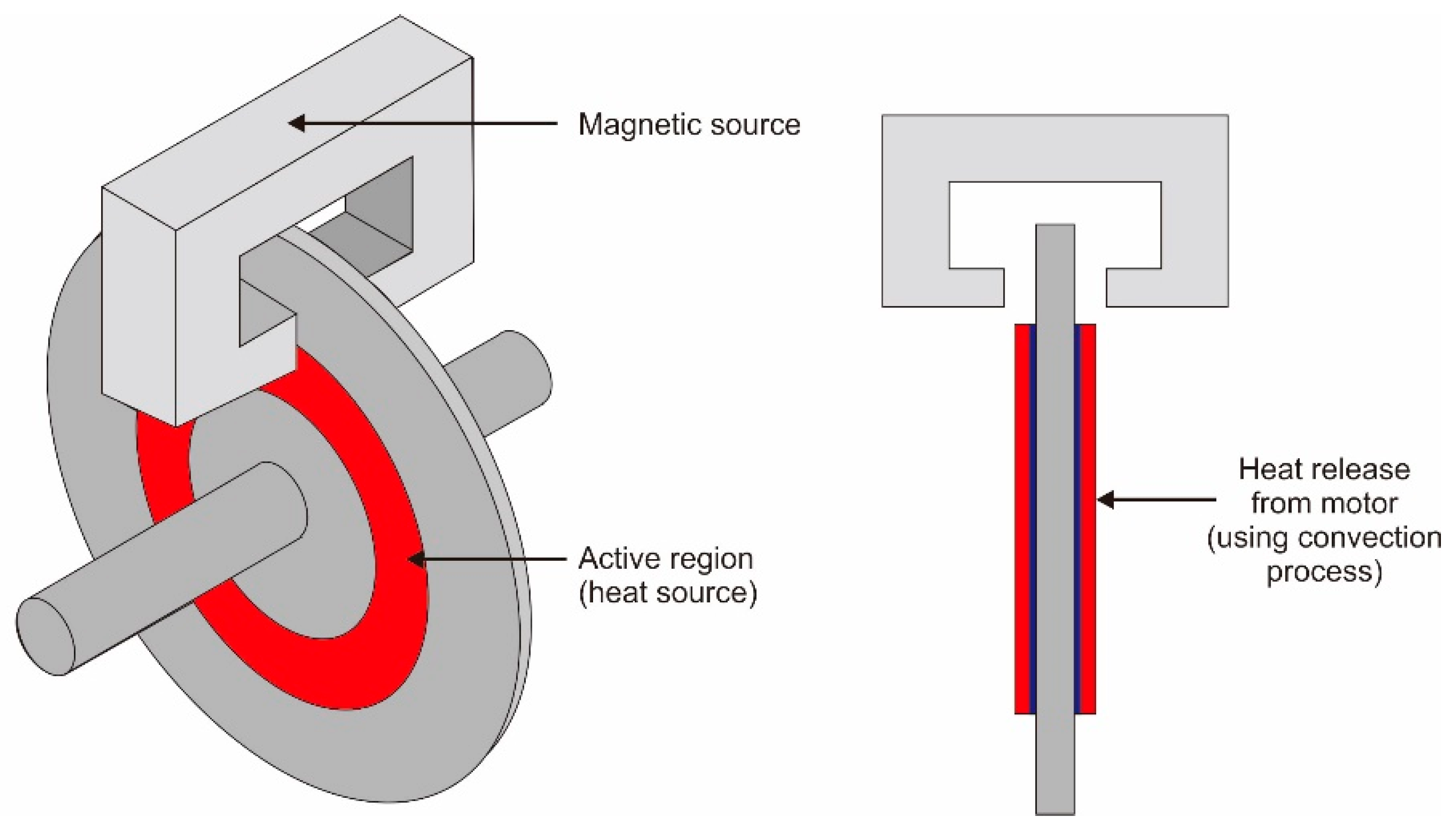
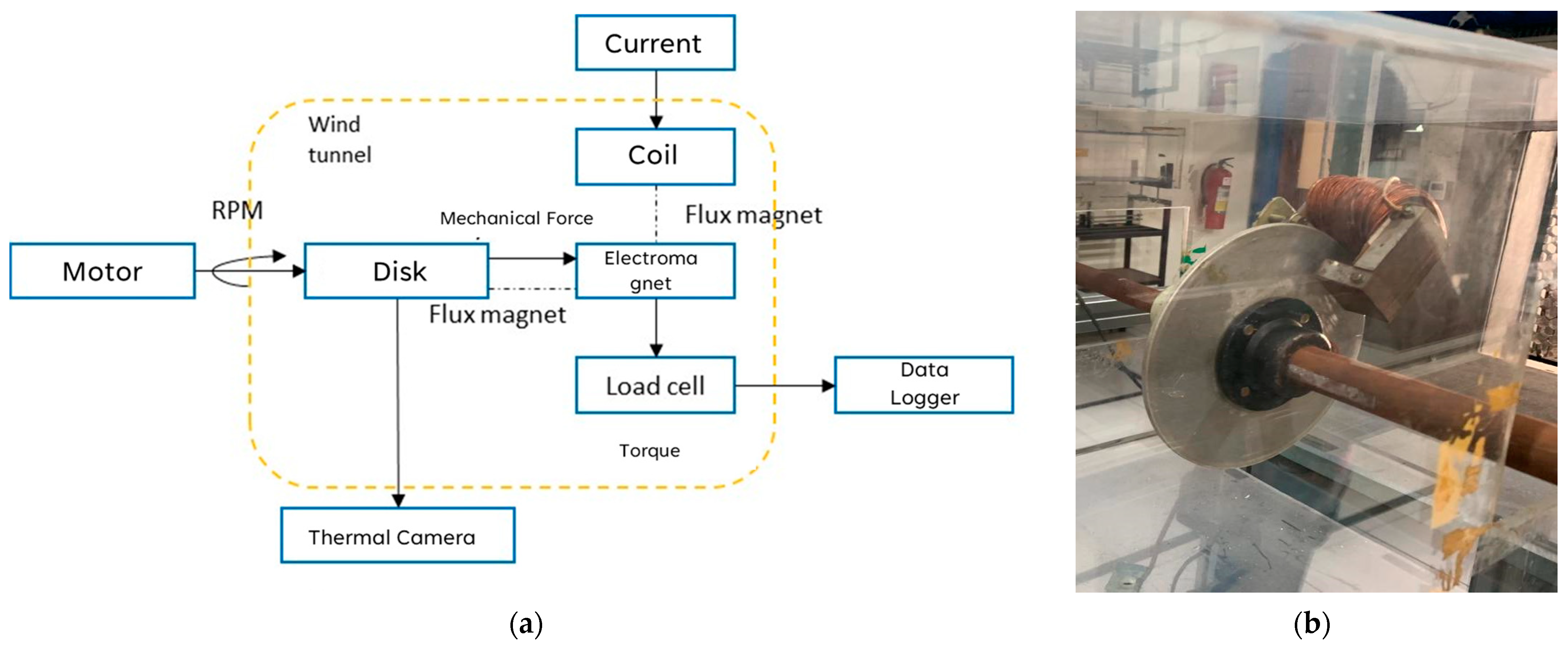
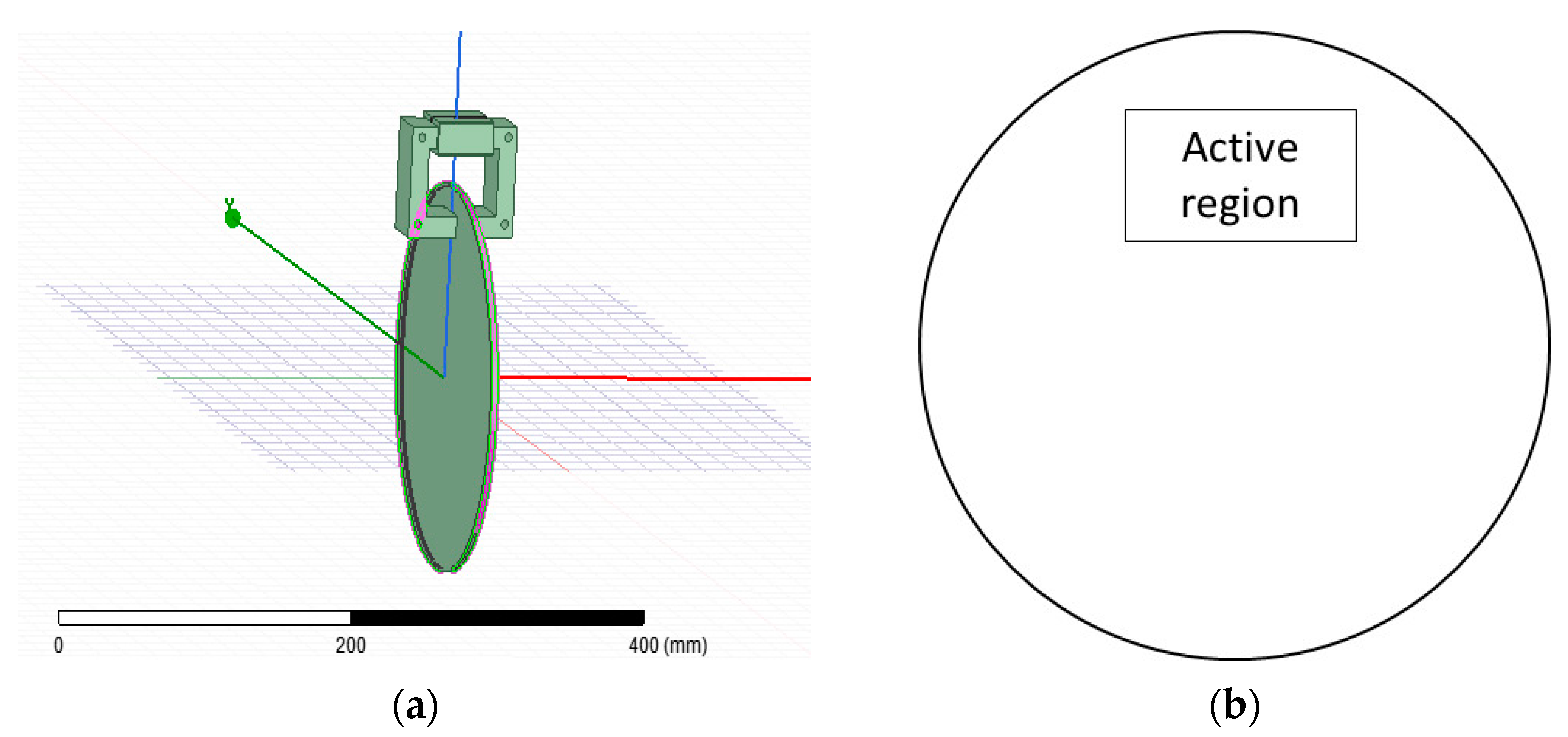

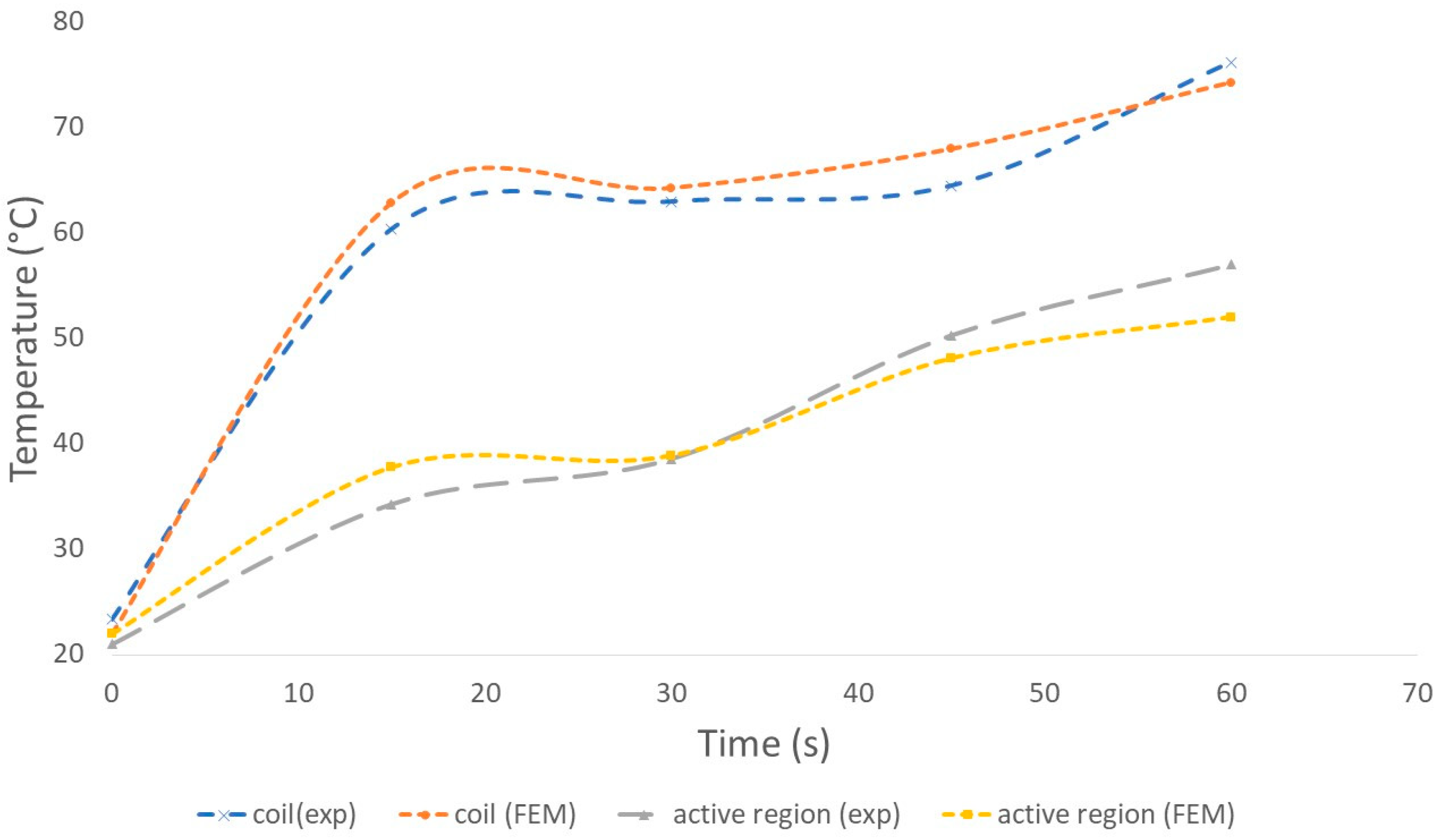
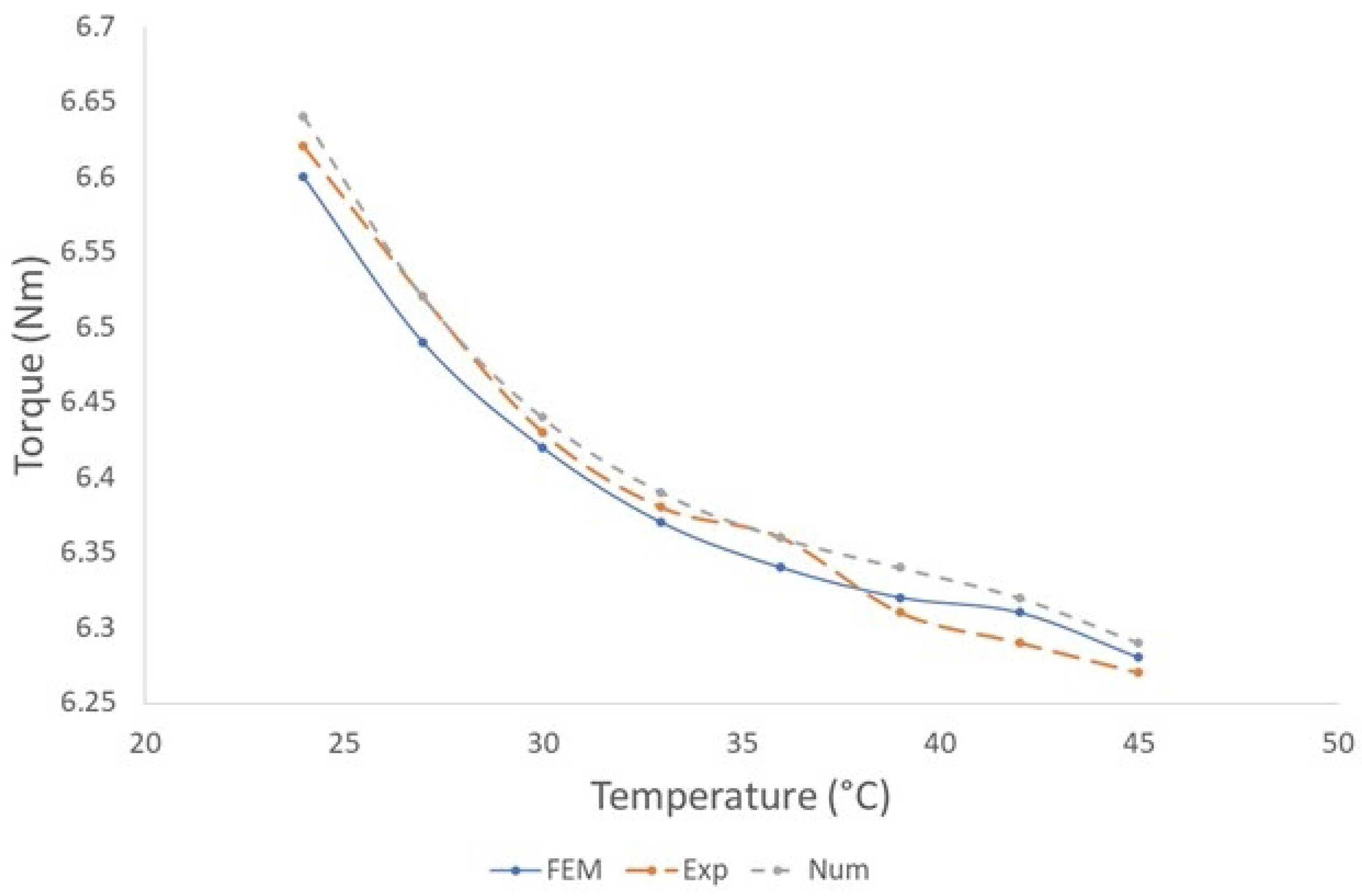
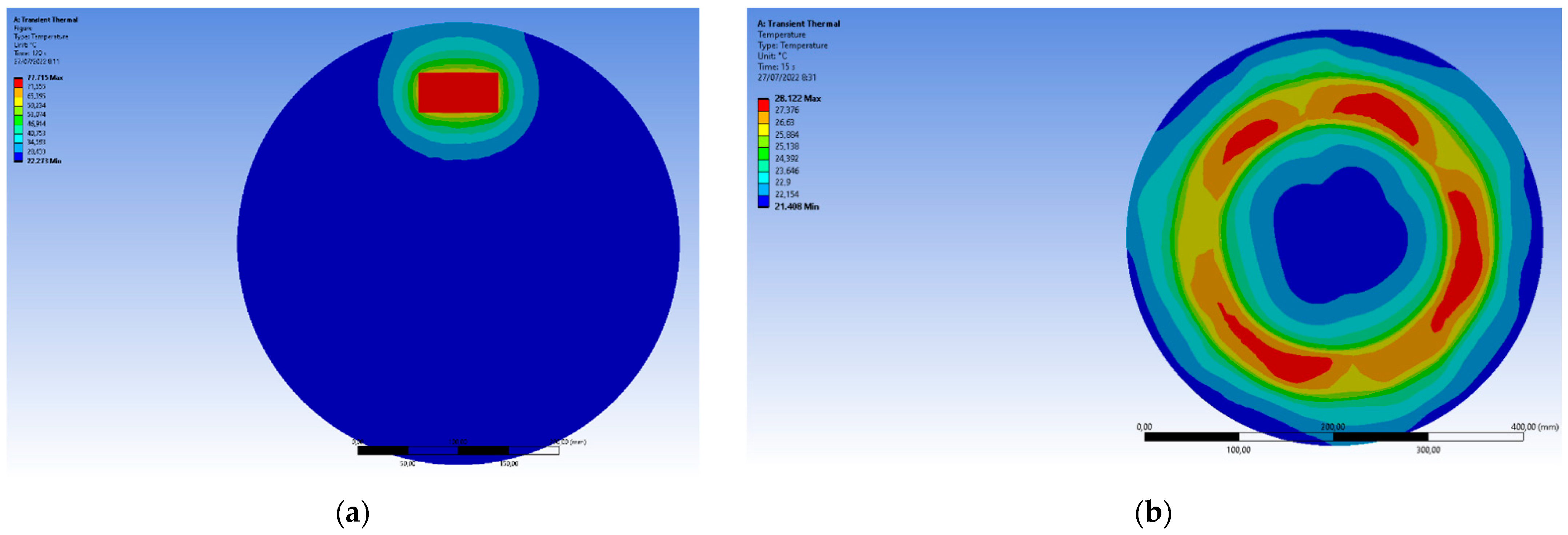
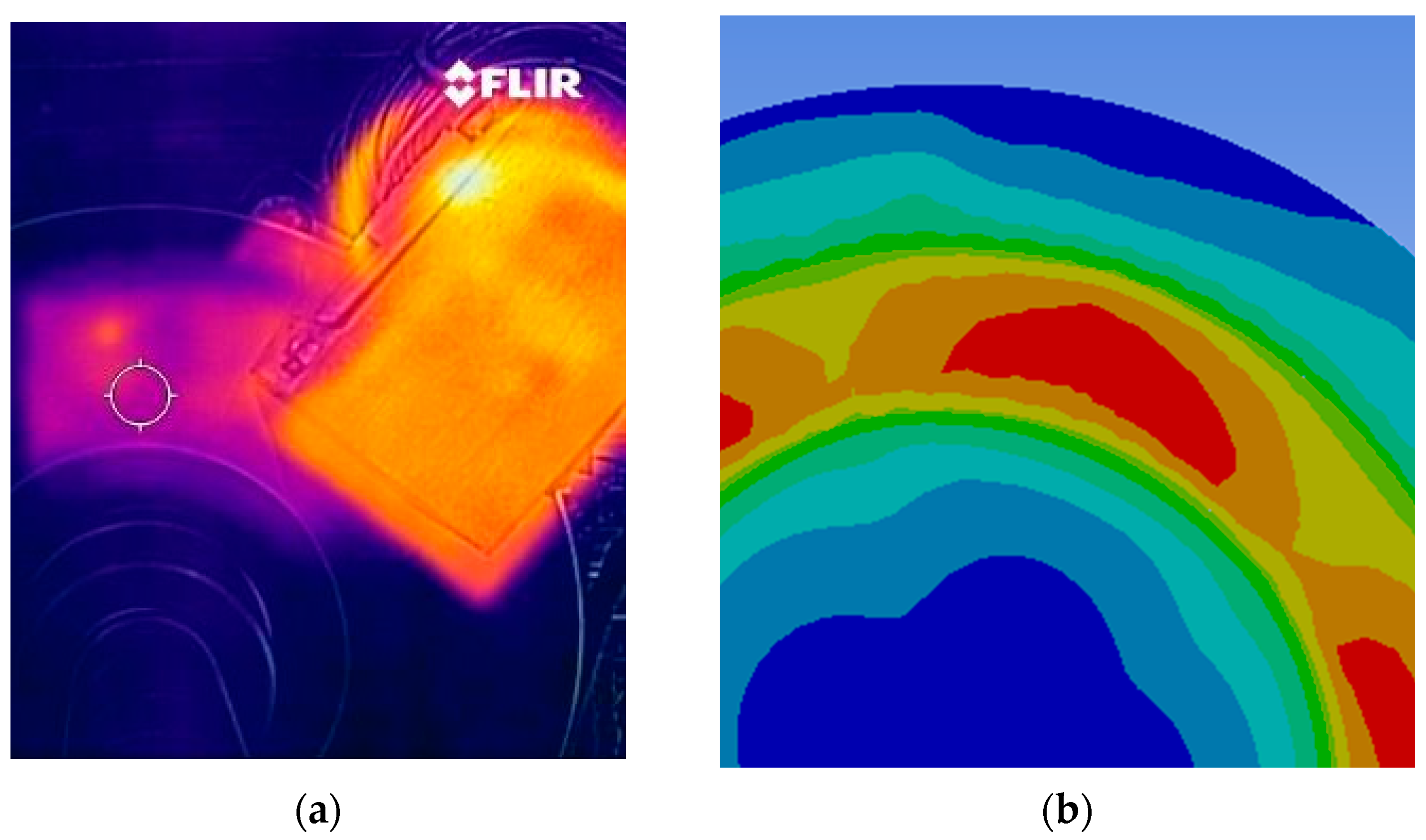

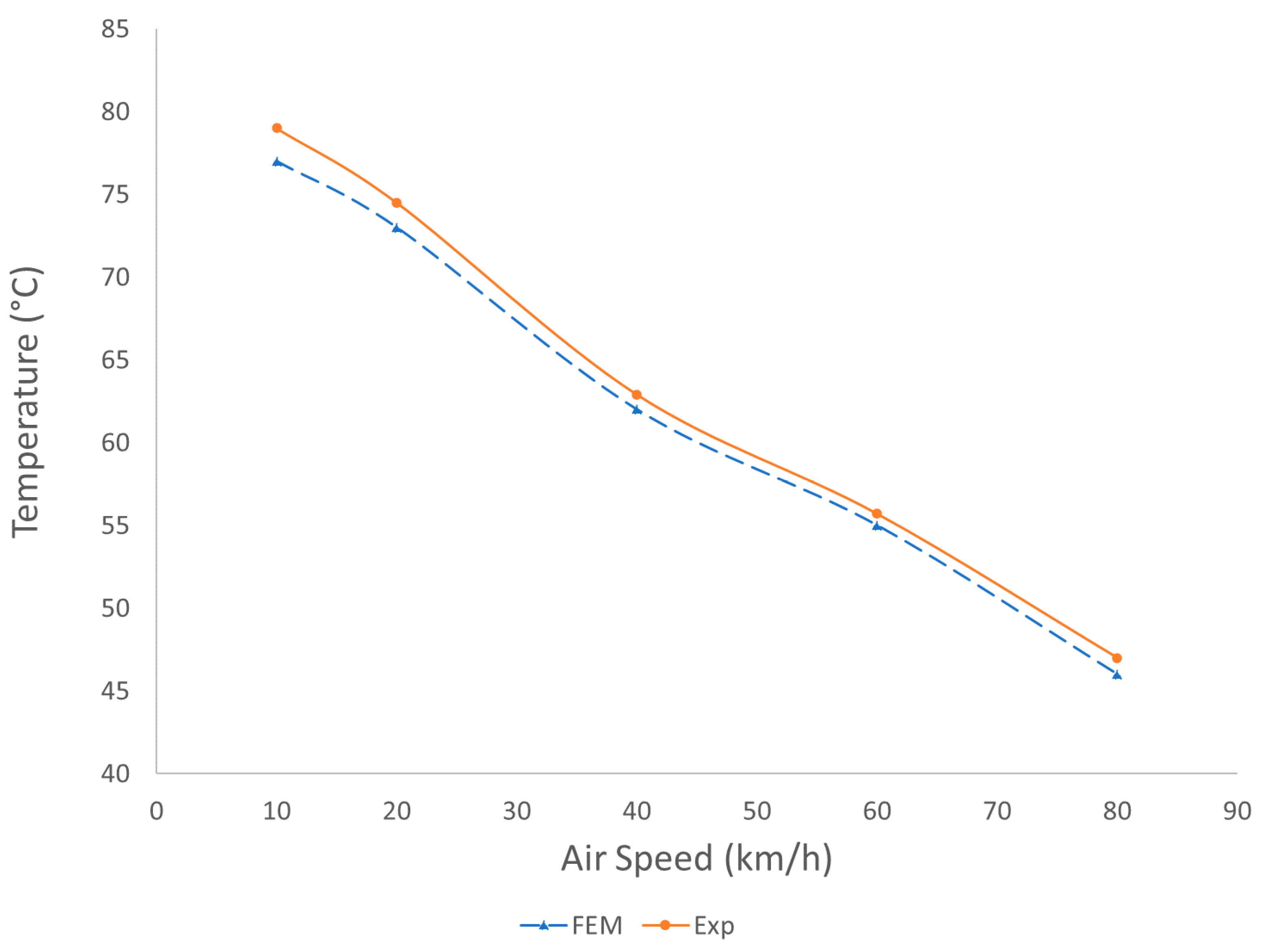
| Parameter | Drum Brake | Disc Brake | Eddy Current Brake |
|---|---|---|---|
| The cross-sectional area of the active region | |||
| Braking torque | 81 Nm | 77.4 Nm | 52.1 Nm |
| Active region temperature | 200 °C | 200 °C | 750 °C |
| Ratio of performance to cross-sectional area | 3.58 | 5.95 | 13.89 |
| Variable | Unit | Value |
|---|---|---|
| Electric current (i) | A | 20 |
| Number of coils (n) | mm | 360 |
| Length of pole shoe (a) | mm | 30 |
| Width of pole shoe (b) | mm | 12.5 |
| Total length of winding core (l) | mm | 248 |
| Center to pole shoe center gap (r) | mm | 83.5 |
| air gap (t) | mm | 0.5 |
| Thickness of disk (d) | mm | 5 |
| Radius of disk brake (r) | mm | 120 |
| - | 1.000022 | |
| - | 400 | |
| Ωm |
| Position | Time (s) | ||||
|---|---|---|---|---|---|
| active region (exp) | 21 | 34.3 | 38.6 | 50.3 | 57 |
| active region (FEM) | 22 | 37.8 | 38.9 | 48.1 | 52 |
| error | 4.5 | 9.3 | 0.8 | 4.6 | 9.6 |
Publisher’s Note: MDPI stays neutral with regard to jurisdictional claims in published maps and institutional affiliations. |
© 2022 by the authors. Licensee MDPI, Basel, Switzerland. This article is an open access article distributed under the terms and conditions of the Creative Commons Attribution (CC BY) license (https://creativecommons.org/licenses/by/4.0/).
Share and Cite
Putra, M.R.A.; Nizam, M.; Tjahjana, D.D.D.P.; Arifin, Z.; Lenggana, B.W.; Inayati, I. Analysis of Heat Generation on Unipolar Axial Eddy Current Brake Disc and Its Effect on Braking Performance. World Electr. Veh. J. 2022, 13, 180. https://doi.org/10.3390/wevj13100180
Putra MRA, Nizam M, Tjahjana DDDP, Arifin Z, Lenggana BW, Inayati I. Analysis of Heat Generation on Unipolar Axial Eddy Current Brake Disc and Its Effect on Braking Performance. World Electric Vehicle Journal. 2022; 13(10):180. https://doi.org/10.3390/wevj13100180
Chicago/Turabian StylePutra, Mufti Reza Aulia, Muhammad Nizam, Dominicus Danardono Dwi Prija Tjahjana, Zainal Arifin, Bhre Wangsa Lenggana, and Inayati Inayati. 2022. "Analysis of Heat Generation on Unipolar Axial Eddy Current Brake Disc and Its Effect on Braking Performance" World Electric Vehicle Journal 13, no. 10: 180. https://doi.org/10.3390/wevj13100180
APA StylePutra, M. R. A., Nizam, M., Tjahjana, D. D. D. P., Arifin, Z., Lenggana, B. W., & Inayati, I. (2022). Analysis of Heat Generation on Unipolar Axial Eddy Current Brake Disc and Its Effect on Braking Performance. World Electric Vehicle Journal, 13(10), 180. https://doi.org/10.3390/wevj13100180









